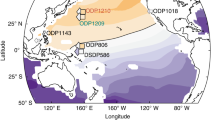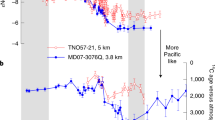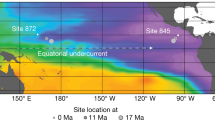Abstract
The deep-ocean circulation is responsible for a significant component of global heat transport. In the present mode of circulation, deep waters form in the North Atlantic and Southern oceans where surface water becomes sufficiently cold and dense to sink. Polar temperatures during the warmest climatic interval of the Cenozoic era (∼ 65 to 40 million years (Myr) ago) were significantly warmer than today, and this may have been a consequence of enhanced oceanic heat transport1. However, understanding the relationship between deep-ocean circulation and ancient climate is complicated by differences in oceanic gateways2, which affect where deep waters form and how they circulate. Here I report records of neodymium isotopes from two cores in the Pacific Ocean that indicate a shift in deep-water production from the Southern Ocean to the North Pacific ∼65 Myr ago. The source of deep waters reverted back to the Southern Ocean 40 Myr ago. The relative timing of changes in the neodymium and oxygen isotope records indicates that changes in Cenozoic deep-water circulation patterns were the consequence, not the cause, of extreme Cenozoic warmth.
This is a preview of subscription content, access via your institution
Access options
Subscribe to this journal
Receive 51 print issues and online access
$199.00 per year
only $3.90 per issue
Buy this article
- Purchase on Springer Link
- Instant access to full article PDF
Prices may be subject to local taxes which are calculated during checkout


Similar content being viewed by others
References
Sloan, L. C. & Rea, D. K. Atmospheric carbon dioxide and early Eocene climate: A general circulation modeling sensitivity study. Palaeogeogr. Palaeoclimatol. Palaeoecol. 119, 275–292 (1995)
Frakes, L. A. & Kemp, E. L. Influence of continental positions on early Tertiary climates. Nature 240, 97–100 (1972)
Levitus, S. Climatological Atlas of the World Ocean (Professional Paper 13, NOAA, Washington DC, 1982)
Tomczak, M. & Godfrey, J. S. Regional Oceanography: An Introduction (Pergamon, London, 1994)
Zachos, J. C., Pagani, M., Sloan, L. C., Thomas, E. & Billups, K. Trends, rhythms, and aberrations in global climate 65 Ma to present. Science 292, 686–693 (2001)
Saunders, A. D., Fitton, J. G., Kerr, A. C., Norry, M. J. & Kent, R. W. in Large Igneous Provinces: Continental, Oceanic, and Planetary Flood Volcanism (eds Mahoney, J. J. & Coffin, M. F.) 45–93 (AGU Geophys. Monogr. 100, American Geophysical Union, Washington DC, 1997)
DePaolo, D. J. & Wasserburg, G. J. Nd isotopic variations and petrogenetic models. Geophys. Res. Lett. 3, 248–252 (1976)
Tachikawa, K., Jeandel, C. & Roy-Barman, M. A new approach to the Nd residence time in the ocean: the role of atmospheric inputs. Earth Planet. Sci. Lett. 170, 433–446 (1999)
Broecker, W. S., Gerard, R., Ewing, M. & Heezen, B. C. Natural radiocarbon in the Atlantic Ocean. J. Geophys. Res. 65, 2903–2931 (1960)
Goldstein, S. L. & Jacobsen, S. B. Nd and Sr isotope systematics of river water suspended material: Implications for crustal evolution. Earth Planet. Sci. Lett. 87, 249–265 (1987)
Halliday, A. N., Davidson, J. P., Holden, P., Owen, R. M. & Olivarez, A. M. Metalliferous sediments and the scavenging residence time of Nd near hydrothermal vents. Geophys. Res. Lett. 19, 761–764 (1992)
Jones, C. E., Halliday, A. N., Rea, D. K. & Owen, R. M. Neodymium isotopic variations in the North Pacific modern silicate sediment and the insignificance of detrital REE contributions to seawater. Earth Planet. Sci. Lett. 127, 55–66 (1994)
Piepgras, D. J. & Jacobsen, S. B. The isotopic composition of neodymium in the North Pacific. Geochim. Cosmochim. Acta 52, 1373–1381 (1988)
Talley, L. D. Distribution and formation of North Pacific intermediate water. J. Phys. Oceanogr. 23, 517–537 (1993)
Reynard, B., Lecuyer, C. & Grandjean, P. Crystal-chemical controls on rare-earth element concentrations in fossil biogenic apatites and implications for paleoenvironmental reconstructions. Chem. Geol. 155, 233–241 (1999)
Staudigel, H., Doyle, P. & Zindler, A. Sr and Nd isotope systematics in fish teeth. Earth Planet. Sci. Lett. 76, 45–56 (1985)
Martin, E. E. & Scher, H. D. Preservation of seawater Sr and Nd isotopes in fossil fish teeth: bad news and good news. Earth Planet. Sci. Lett. 220, 25–39 (2004)
Thomas, D. J. in Isotopic and Elemental Tracers of Late Cenozoic Climate Change (eds Surge, D. & Mora, G) (GSA Spec. Publ., Geological Society of America, in the press)
Rutberg, R. L., Hemming, S. R. & Goldstein, S. L. Reduced North Atlantic deep water flux to the glacial Southern Ocean inferred from neodymium isotope ratios. Nature 405, 935–938 (2000)
Larson, R. L. & Pitman, W. C. III Worldwide correlation of Mesozoic magnetic anomalies and its implications. Geol. Soc. Am. Bull. 83, 3645–3661 (1972)
Thomas, D. J., Bralower, T. J. & Jones, C. E. Neodymium isotopic reconstruction of late Paleocene – early Eocene thermohaline circulation. Earth Planet. Sci. Lett. 209, 309–322 (2003)
Bice, K. L., Barron, E. J. & Peterson, W. H. Continental runoff and early Cenozoic bottom-water sources. Geology 25, 951–954 (1997)
Eldholm, O. & Thomas, E. Environmental impact of volcanic margin formation. Earth Planet. Sci. Lett. 117, 319–329 (1993)
Kurtz, A. C., Kump, L. R., Arthur, M. A. & Paytan, A. Early Cenozoic decoupling of the global carbon and sulfur cycles. Paleoceanography 18, 14-1–14-14 (2003)
Boyle, E. A. Cadmium, zinc, copper, and barium in foraminifera tests. Earth Planet. Sci. Lett. 53, 11–35 (1981)
Boyle, E. A. & Keigwin, L. D. Comparison of Atlantic and Pacific paleochemical records for the last 250,000 years: changes in deep ocean circulation and chemical inventories. Earth Planet. Sci. Lett. 76, 135–150 (1985)
Tanaka, T. et al. Jndi-1: a neodymium isotopic reference in consistency with La Jolla neodymium. Chem. Geol. 168, 279–281 (2000)
Bralower, T. J. et al. Proc. ODP Init. Rep. [online] 198, 〈http://www-odp.tamu.edu/publications/198_IR/chap_05/chap_05.htm〉 〈http://www-odp.tamu.edu/publications/198_IR/chap_07/chap_07.htm〉 (2002).
Acknowledgements
The author thanks T. Bralower, U. Rohl and N. Slowey for discussions, the science party, staff and crew of ODP Leg 198, and the Ocean Drilling Program for supplying sample material. This work was supported by JOI.
Author information
Authors and Affiliations
Corresponding author
Ethics declarations
Competing interests
The authors declare that they have no competing financial interests.
Rights and permissions
About this article
Cite this article
Thomas, D. Evidence for deep-water production in the North Pacific Ocean during the early Cenozoic warm interval. Nature 430, 65–68 (2004). https://doi.org/10.1038/nature02639
Received:
Accepted:
Issue Date:
DOI: https://doi.org/10.1038/nature02639
This article is cited by
-
The role of mountains in shaping the global meridional overturning circulation
Nature Communications (2024)
-
Sustained mid-Pliocene warmth led to deep water formation in the North Pacific
Nature Geoscience (2022)
-
Proxy evidence for state-dependence of climate sensitivity in the Eocene greenhouse
Nature Communications (2020)
-
Late Eocene onset of the Proto-Antarctic Circumpolar Current
Scientific Reports (2019)
-
Tracking the spatiotemporal variations of statistically independent components involving enrichment of rare-earth elements in deep-sea sediments
Scientific Reports (2016)
Comments
By submitting a comment you agree to abide by our Terms and Community Guidelines. If you find something abusive or that does not comply with our terms or guidelines please flag it as inappropriate.



